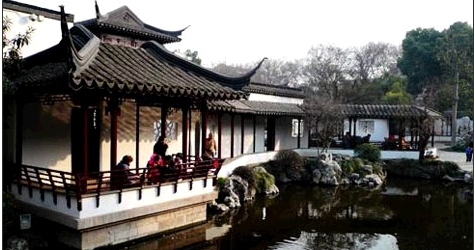 One of the structures in traditional Chinese landscape gardening is the xie, a special form of pavilion. The earliest xie referred to the wood houses built on high terraces, but with the change of taste it became more and more the fashion in later epochs to build the single-storyed xie on the shore of lakes or ponds.
One of the structures in traditional Chinese landscape gardening is the xie, a special form of pavilion. The earliest xie referred to the wood houses built on high terraces, but with the change of taste it became more and more the fashion in later epochs to build the single-storyed xie on the shore of lakes or ponds.
It is the special feature of the shuixie (waterside pavilion) to be rectangular or near square in plan figure, half erected on land and half over water supported by stone pillars driven into the lake bottom. This structure is walled not with bricks but with wood frames having fancy windows on all sides. The side on the water is bordered with railings and equipped with seats, fixed or movable, to provide visitors with a vantage point to feast their eyes on the scenes of the lake.
A typical example of this structure is the waterside pavilion in Xiequ Garden (Garden of Harmonious Interest) of the Summer Palace, from which Cixi, the all-powerful Empress Dowager of the late Qing Dynasty, is said to have enjoyed herself at fishing. Other well-known buildings of the same style include Furongxie in Zhuozheng Yuan (the Humble Administrator's Garden) of Suzhou, Shuixie in the Zhongshan Park of Beijing and Shuixinxie in the Mountain Resort of Chengde.





